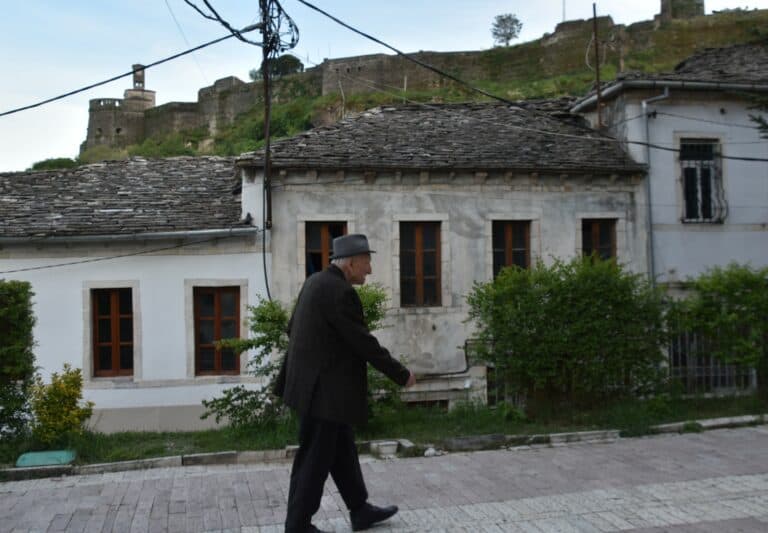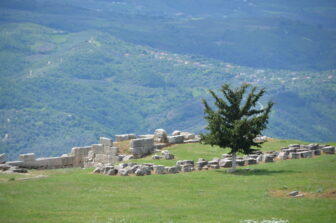Byllis
Byllis is one of the most important and evocative archaeological sites in Albania, located on a high plateau overlooking the valley of the Vjosa River, near the town of Ballsh in the southern part of the country. Surrounded by unspoiled rolling hills and wrapped in silence, Byllis is an ancient city that tells a story spanning more than two millennia, intertwining Illyrian origins with Greek influence and Roman rule. Today, it is an ideal destination for those seeking a deep immersion in both history and the natural beauty of the Albanian interior.
Founded in the 4th century BCE by the Illyrians, the indigenous people of Albania, Byllis was initially a powerful fortified city and served as the main political, military, and cultural center of the Bylliones tribe. The massive stone walls that once encircled the city, covering an area of around 30 hectares, are still partially visible, attesting to the strategic importance and military strength of this ancient polis. Over the centuries, Byllis came under the influence of Greek culture—especially in its institutions and architecture—while maintaining a strong Illyrian identity. Later, it was absorbed into the Roman Empire, entering a new phase of prosperity, as evidenced by the monumental remains scattered across the site.
Today, the archaeological park of Byllis is vast, peaceful, and full of wonder. One of its most impressive structures is the theater, built during the Hellenistic period and later expanded by the Romans. With a capacity of around 7,500 spectators, the theater opens out to a sweeping view of the valley below, offering visitors a stunning panorama that alone justifies the journey. The cavea, orchestra, and part of the stage are still clearly defined, allowing the imagination to bring to life the performances and ceremonies that once animated the space.
In addition to the theater, visitors can explore the remains of temples, stoas, gymnasiums, paved streets, cisterns, and private homes—all built with a remarkable degree of craftsmanship. The urban layout of Byllis reveals a city planned with care and sophistication, comparable to other major Mediterranean settlements of the time. During the Christian era, particularly between the 5th and 6th centuries CE, the city experienced a revival as a bishopric and witnessed the construction of several early Christian basilicas. The mosaics that decorate the floors of these churches are among the most exquisite found in Albania, featuring intricate geometric patterns, Christian symbols, and stylized animals. These artworks are not only a testament to the artistic skill of local craftsmen but also to the deep spirituality of the community.
The natural setting of Byllis is one of its defining features. Perched at an altitude of over 500 meters, the site offers breathtaking views of hills, valleys, rivers, and, on clear days, even the distant Adriatic Sea. The atmosphere is often one of complete serenity, enhancing the sense of timelessness and making the experience even more meaningful. Visitors can wander freely among the ruins, exploring each corner at their own pace, without the crowds that often characterize more famous archaeological sites.
Byllis also holds spiritual significance. The presence of basilicas and stone-carved crosses reminds visitors that this was an important Christian center in late antiquity. Some of the churches retain their original floor plans and portions of their walls, offering rare examples of early medieval religious architecture in Albania. The fusion of sacred architecture, silence, and wide open spaces creates an experience that goes beyond historical exploration—it becomes a moment of reflection and quiet connection to the past.
Reaching Byllis requires a short journey along secondary roads that wind through the hills, but the route itself is part of the charm and anticipation of discovering something special. The site is well signposted and includes a small visitor center and basic facilities, though it remains largely untouched by mass tourism. For this reason, visitors are advised to bring water, snacks, and to wear comfortable shoes for walking on uneven ground.
In recent years, there have been significant efforts to preserve and promote Byllis through restoration projects, archaeological campaigns, and cultural initiatives. Despite these developments, the site has maintained its raw, unspoiled atmosphere. It is a place where nature and history blend harmoniously, offering a genuine and contemplative experience.
In conclusion, Byllis is far more than an archaeological site—it is a window into Albania’s ancient past, a silent witness to the civilizations that once thrived in the region. It is a perfect destination for lovers of archaeology, nature, solitude, and discovery. Here, far from the noise of the cities, one can listen to the wind whispering through broken columns, watch birds fly above ancient stones, and imagine the life that once flourished in this high citadel. Byllis invites visitors to slow down, look deeper, and be moved by the quiet power of memory and beauty.
Pleasant ruins
[Apr. 2024] I continue talking about the Italian tour in Albania. The next day we left Berat and headed for Gjirokaster. Our first destination was the ruins of Byllis. My husband and I are not…


